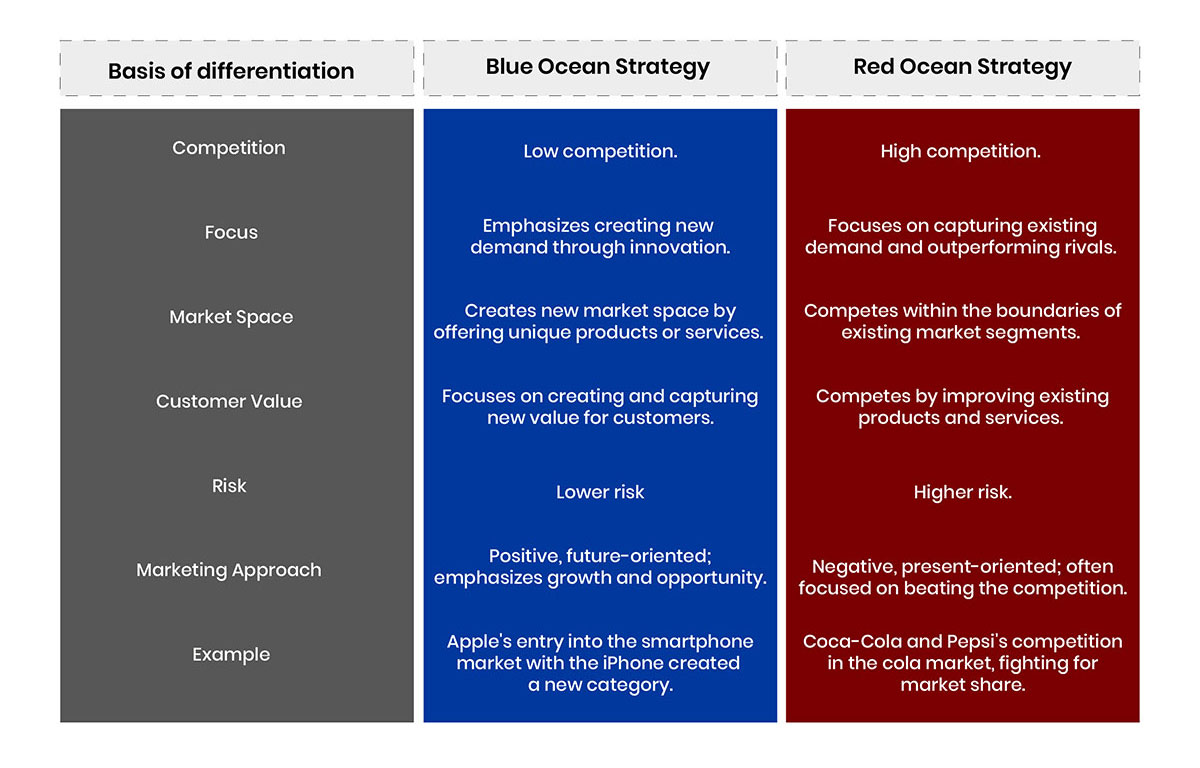Strategies are essential for succeeding in the business world. Companies navigate the competitive seas with the help of two essential approaches: the Red Ocean and Blue Ocean strategies. The Red Ocean strategy emphasizes competition and gradual improvements while taking on established competitors in a well-known market. On the other hand, the Blue Ocean strategy stimulates businesses to venture into uncharted territory, establishing new markets through creative thinking and originality. These strategic decisions set the direction for a company's journey through the vast ocean of business opportunities and influence how it deals with the difficulties of competition and market development.
The traditional business strategy known as the "Red Ocean" strategy is when businesses compete in their current markets to outperform competitors and capture a larger market share. This frequently entails emphasizing differentiation, price, or a mix of the two. The phrase "Red Ocean" refers to a metaphorical situation in which competitors are engaged in a fierce battle for the same customer base. This tactic has advantages even though it might seem obvious.
Benefits
Red Ocean's strategies usually center on using well-known tactics to compete in already-established market spaces. Cost leadership, for instance, entails lowering production costs within the sector to draw in price-conscious clients. In contrast, product differentiation emphasizes providing distinctive features to make a name for yourself in a crowded market.
The fast-food market is highly competitive, with high-profile ads, aggressive pricing, and new product varieties. McDonald's is a prime example of a company that has successfully used the red ocean approach. All that McDonald's accomplished was to stay under the radar while providing excellent burgers made with fresh ingredients in a restaurant with a conventional aesthetic. When it comes to the food industry, McDonald's delivers on authenticity.
The Blue Ocean Strategy is an innovative marketing technique that emphasizes innovation over direct competition to revive companies. The strategy, which was first introduced in 2005 by W. Chan Kim and Renée Mauborgne, entails creating new market niches and increasing customer demand to eliminate the need for competition.
Benefits
Instead of competing for a piece of the market that already exists, Blue Ocean's strategies focus on generating new value for their clients. For instance, Cirque du Soleil transformed the business of circus around the world, by fusing theater and circus elements, making it appealing to a broader audience than just traditional circus visitors. By carving out a new market niche, this calculated action helped the company break away from the fierce rivalry within the established circus sector.
Meta (Formerly Facebook): CEO Mark Zuckerberg declared in October 2021 that Facebook would now go by the name Meta. When Facebook first launched, social networks were a completely new industry. After more than ten years, social networking has grown into a monopoly. By changing its name, Meta can focus its product offerings on the "metaverse," an uncharted territory that is thrilling and novel. Although the strategy shift has yet to be proven, it is clear that the idea of moving from the red ocean of social media to the blue ocean of the metaverse influenced the decision.
The two concepts that outline different market strategies are the Red Ocean Strategy and the Blue Ocean Strategy. Here's a table comparing them:

A company's competitive environment is shaped in the business world by selecting between red-ocean and blue-ocean strategies. The Blue Ocean business strategy promises uncharted territory and innovative potential, while the Red Ocean presents a well-known battlefield with fierce rivalry. The decision between these approaches ultimately comes down to a company's objectives, willingness to take on risk, and desire to explore creative paths in the wide and constantly evolving world of business.

CredBadge™ is a proprietary, secure, digital badging platform that provides for seamless authentication and verification of credentials across digital media worldwide.
CredBadge™ powered credentials ensure that professionals can showcase and verify their qualifications and credentials across all digital platforms, and at any time, across the planet.

Keep yourself informed on the latest updates and information about business strategy by subscribing to our newsletter.